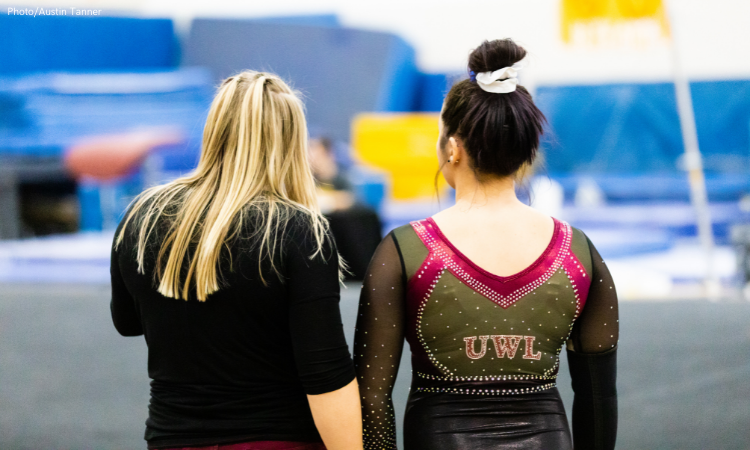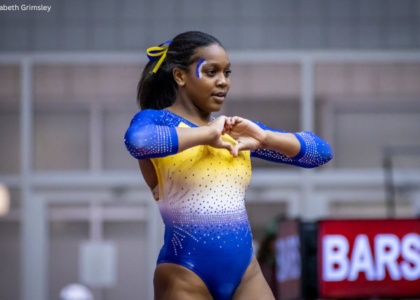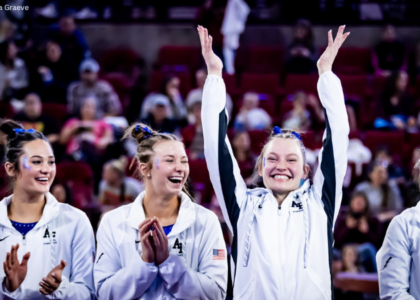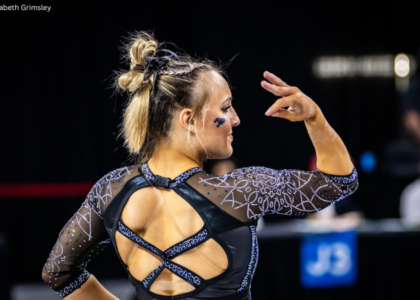Leotards are the unofficial fifth event of gymnastics. After all, how many conversations immediately spawn when a team teases a new leotard, and how much does social media explode with opinions when they’re finally revealed. With just as much conversation as controversial scoring, rankings, falls and sticks, the leotard is a talking point on the internet. But leotards, like everything else in college gymnastics, vary from division to division and from team to team. That difference in status comes down to budgets and decisions.
Looking across NCGA programs, including Ithaca,UW- La Crosse and Springfield, the room in the budget for leotards poses a problem for teams. At its very core, leotards are the team uniform, the way a soccer or hockey team has jerseys. And the budget limits how a smaller program is able to spend its money. The La Crosse has just $700 available to purchase new leotards, an amount it can thankfully roll over from year to year, but at the cost of not purchasing any new leotards that season. With a team of 22 gymnasts, that’s a mere $20 allotted per leotard. Even with bulk sale options available, that’s an unrealistic and unsustainable number.
Teams turn to junior gymnastics programs to help grow their available budget, but with COVID shutting down not only collegiate programs but opportunities to fundraise, La Crosse has had to turn to alumni for fundraising for what is an essential piece of equipment or else make budget cuts elsewhere to funnel more money toward new leotards. Although these garments do have a fairly long life cycle—around three to four years—teams still have to grapple with designs and patterns that go out of production while the leotard is still being used. And they aren’t always in a position to have spare leotards on hand.
In fact, most teams hold a limited amount, just enough for the current team. Some order several of each size, hoping it’ll be enough to cover everyone and that it will be enough for the coming seasons, too. Those competing have the first chance at getting their preferred size. Whether a program gets a new leotard every single, every two or every three years, there’s never more than three to choose from at any given time, and some programs only have one leotard on hand, although most average two.
Unlike bigger programs, such as those in the SEC or the Pac-12 when seniors can keep a leotard, most smaller programs can’t afford such a luxury. However, as leotards are phased out, alumni can contact their former program in search of a favorite design that might still be hanging around or even purchase it from their former team.
When it comes to designing the leotard, some coaches are able to offer the gymnasts a chance for their voices to be heard. For Springfield, gymnasts are able to design their perfect leotard to provide inspiration to head coach Jennifer Najuch. For all schools though, the designs, logos and text all need final approval, especially when involving licensing.
For Springfield, the message in the design is at the forefront, though. The signature Springfield “S” is to be worn with pride, an emphasis on the program’s mascot, Pride. It also finds ways to incorporate the word “Pride,” often in an emblem on the back of the leotard. This is meant to mirror a more traditional athletic jersey.
This conceptual design is a favorite of Najuch, as it’s a clean athletic look that can be flattering on any gymnast—another important facet when funds are limited. This design is one Springfield continues to use, relying on symbolism to create an impression for both gymnasts and fans. The latest leotard, known by the team as the “Triangle” uses more sparkles and shine than previous designs but has a repeated triangle pattern to represent the philosophy of student education at the college.
Some schools opt for a color focus, such as Ithaca, which brings a spotlight to its school colors, blue and gold, weaving in the school logo when it can. Missing from the Ithaca leotard and school as a whole, however, is a mascot. When the vote went up for an official mascot in the fall of 2010, enough current students and alumni were mystified with the phoenix, flying squirrel and lake beast options that the idea was quickly dropped.
For most, leotards are more than just a flashy jersey, they’re an extension of the gymnastics teams they represent. But costs can hamper a program. From brand to design to embellishments, at the end of the day the cost is what looms over every program. Some teams dream of a season with a full roster of leotards to choose from while others are happy with one at a time in order to take the chance to savor and enjoy the newness that comes with a sparkling, fresh design.
As for the leotards that stick around? Surprisingly most teams don’t find to have any extra luck or superstition from one particular leotard, unlike other sports like baseball, although leotards will pick up names based on successful meets. But no matter the success, the budget doesn’t move from one year to the next, so a stellar, championship-winning season means nothing for a new piece of gear the next fall.
With so many teams already on a limited budget and severely limited by COVID for fundraising, not only are coaches and teams juggling getting back into the swing of training, routines and weekly competitions after nearly a year and a half away, but many budgets were frozen during that time. How does this change? Aside from attending meets, it’s answering the calls when teams reach out about apparel or donating to programs you want to support. You may love the leotards, but for teams, they’re wearing their hearts on their sleeves.
READ THIS NEXT: Differences in Budgets Mean Differences in Reality in NCAA Gymnastics
Article by Allison Freeman
Like what you see? Consider donating to support our efforts throughout the year!





5 comments